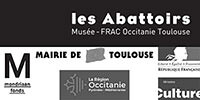Restrospective
September 21, 2018–January 13, 2019
Dark Optics
September 21, 2018–February 10, 2019
76 allées Charles de Fitte
Les Abattoirs, Musée - Frac Occitanie Toulouse
31300 Toulouse
France
Hours: Wednesday–Sunday 12–6pm,
Thursday 12–8pm
T +33 5 62 48 58 00
lesabattoirs@lesabattoirs.org
Jacqueline de Jong, Retrospective
Born in 1939 in Hengelo (The Netherlands), lives and works in Amsterdam.
This first retrospective by Dutch artist Jacqueline de Jong (born in 1939) offers a panorama of her creation since her historic artworks of the 1960s, her membership of the Situationist International, and her participation in the events of May ‘68, through to her most recent works—paintings, books or jewellery.
The exhibition reveals the rich diversity of the artistic programme and life of Jacqueline de Jong. In the late 1950s, she worked at the Stedelijk Museum in Amsterdam directed by Willem Sandberg. There, she met the Cobra artist Asger Jorn and the founder of the Situationist International Guy Debord. It was in 1961, in Paris, after classes in etching, that her own artistic pathway was to be mapped. In 1962, she founded The Situationist Times, the only English-speaking magazine of the movement. Her figurative, expressionistic art played on a bestiary that was at once monstrous and naïve (Suicide Paintings, Accidental Paintings, Le Salo et les Salopards). Her painting also borrows from everyday objects echoing the combine-paintings and situationist subversion. In May ‘68, buoyed by revolutionary ideals, she joined the rebellion by creating screen-printed posters, prior to her return to Amsterdam in 1971.
The work of Jacqueline de Jong combines eroticism, violence, and humour, often confusing humans and animals and flirting with the limits of humanity. Jacqueline de Jong experienced the avant-garde of the 1960s and the comeback of painting in the 1980s with characteristic freedom, disobedience, and political commitment. Since the 2000s, she has created books and paintings that bear the motifs of potatoes, which she also transforms into jewellery after harvesting them, drying them out, then dipping them in gold. Since the 2000s, her work has enjoyed a revival: besides the acquisition of her archives by Yale University in 2011, it was recently the subject of collective exhibitions (Musée Tinguely, Basel, 2007; Bibliothèque nationale de France, Paris, 2013; Blume and Poe, Los Angeles, 2015; Château Shatto, Los Angeles, 2017; Mamco, Geneva, 2018, etc.), and her jewellery has also been exhibited (Musée d’art moderne de la Ville de Paris, 2016; Musée des Arts décoratifs, Paris, 2018). In 2019, her work will be shown in a solo exhibition at the Stedelijk Museum in Amsterdam.
David Claerbout, Dark Optics (Vision de nuit)
For the past 20 years, David Claerbout, born in 1969 in Courtrai and living in Antwerp (Belgium), has developed an original corpus combining film, painting, and photography. His first films, in 1997, were developed in the midst of the image revolution: the transition from analogue to digital. His work, present in the biggest museum and international collections, has since explored the intersections between still and moving images. Today, on the ground floor of Les Abattoirs, the artist juxtaposes a dozen monumental artworks created between 1997 and 2017. This exhibition, Dark Optics, questions as much the reality of the landscape around us—modern urban architecture or elements from the natural world (trees, water, wind, etc.)—as it does the reality of the images before us.
The exhibition is firmly rooted in a broader history of photography, film, and video. Devised in two parts, it analyses the transition from the analogue image on film to dematerialised digital creation. The calm north wing of Les Abattoirs presents, in black and white, the early days of photography and cinema in the 19th century, while the south aisle shows the development of colour and sound, followed by the digital age. While the current image-production process increasingly takes place on computers rather than through the camera’s lens, the artist reveals the emergence of a new optical form, suited to the multimedia experience, which he calls “dark optics.”
And also at Les Abattoirs:
Eduardo Basualdo, La cabeza de Goliath
November 8, 2018–February 10, 2019
Sound and Vision, 100 vinyl records from les Abattoirs Collection
November 8, 2018–February 10, 2019
New outdoor artwork: Raphaël Zarka, Cycloïd Ramp
November 8, 2018–summer 2019
Béatrice Cussol, les parties
September 21, 2018–February 9, 2019
Mezzanine Sud
November 8, 2018–February 10, 2019
-Mazaccio & Drowilal
-Marie-Luce Nadal
-Agathe Pitié
(with financial support of Les Amis des Abattoirs)


